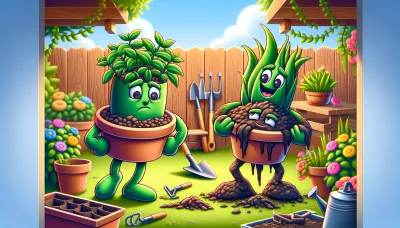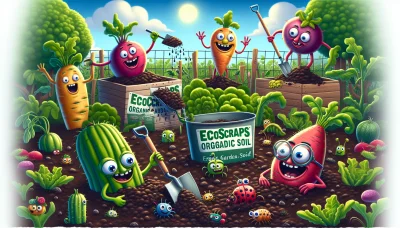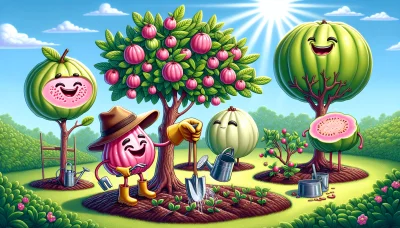What to do with persimmons Quiz
Test Your Knowledge
Question of
What to Do with Persimmons: A Gardener's Guide
Persimmons are a unique and flavorful fruit that have gained popularity among gardeners and food enthusiasts alike. Known for their sweet taste and versatile use in both cooking and baking, these fruits can add a special touch to any garden. Growing persimmons can be a rewarding experience, offering a beautiful addition to the landscape and a delicious harvest in the fall.
Types of Persimmons
Persimmons are a popular fruit commonly grown in gardens, known for their sweet taste and vibrant orange color. Among the various types, the Fuyu and Hachiya varieties stand out for their distinctive characteristics and uses. The Fuyu persimmon is squat and somewhat resembles a tomato in shape. It is non-astringent, meaning it can be eaten while still firm, offering a crunchy texture with a sweet, mild flavor. On the other hand, the Hachiya persimmon is acorn-shaped and is astringent. This variety needs to be fully ripe and soft before consumption, at which point it has a rich, sweet flavor. Both types offer unique tasting experiences and are versatile in culinary uses, from fresh eating to baking and preserves.
Growing Persimmons in Your Garden
- Choosing the Right Variety: Make sure to select a persimmon variety that is well-suited to your climate. There are many types, including Fuyu and Hachiya, which are popular for their adaptability.
- Soil Requirements: Persimmons require well-drained soil with a neutral pH. You can test your soil and amend it with compost to improve its structure and fertility.
- Planting: Plant your persimmon tree in a location that receives full sunlight. Dig a hole twice as wide and just as deep as the root ball, placing the tree at the same depth it was in the pot.
- Watering: After planting, water your persimmon tree deeply to help establish its roots. Continue to water it regularly, allowing the soil to dry out slightly between watering sessions.
- Sunlight: Persimmon trees need at least 6 hours of direct sunlight each day. Choose a planting site that is not shaded by buildings or other trees.
- Mulching: Apply a layer of organic mulch around the base of the tree to help retain soil moisture, regulate soil temperature, and reduce weed growth.
- Fertilizing: Feed your persimmon tree with a balanced fertilizer in early spring before new growth begins. Avoid over-fertilizing, which can lead to poor fruit production.
- Pruning: Prune persimmon trees in late winter to remove any dead or diseased wood and to shape the tree. This encourages healthy growth and fruit production.
- Harvesting: Persimmons are typically ready to harvest in the fall when they are fully colored and slightly soft to the touch. Use a pair of pruning shears to cut the fruit from the tree, leaving a bit of the stem attached.
Harvesting and Storing Persimmons
To properly harvest persimmons, wait until the fruit is fully colored but still firm to the touch. Gently twist the fruit off the branch, taking care not to bruise it. For storing, keep unripe persimmons at room temperature until they soften. Ripe persimmons can be stored in the refrigerator to extend their freshness. To further prolong their shelf life, place them in a plastic bag with holes for ventilation. Remember, persimmons are best enjoyed when they are soft and fully ripe.
Creative Uses for Persimmons in the Kitchen
- Persimmon Jam: A sweet and tangy spread for your morning toast or cheese platter.
- Spiced Persimmon Bread: Moist and flavorful bread, perfect for fall and winter breakfasts.
- Persimmon and Arugula Salad: A refreshing combination of sweet persimmon, peppery arugula, and a hint of balsamic.
- Roasted Persimmons: Simple yet delicious, roasted persimmons can be a great side dish or dessert.
- Persimmon Smoothie: Blend persimmons with bananas, a touch of cinnamon, and your favorite milk for a nutritious drink.
- Persimmon Pudding: A traditional dessert that is rich, custardy, and perfect for the holiday season.
- Persimmon Salsa: A unique twist on salsa, combining persimmon with onion, cilantro, and lime for a fresh dip or topping.
- Persimmon Tarts: Sweet, individual tarts that showcase the delicate flavor of persimmons.
- Grilled Persimmons: Grilling brings out the sweetness of persimmons, making them a great addition to salads or as a standalone treat.
- Persimmon Caprese: Swap tomatoes for sliced persimmons in this twist on the classic Caprese salad for a sweet and savory combination.
Persimmon Health Benefits
Persimmons are a powerhouse of nutrition, offering a wide range of vitamins, minerals, and fiber that contribute to overall health and well-being. These delicious fruits are particularly rich in vitamins A and C, which are essential for immune function, skin health, and vision. They also provide a good amount of manganese and dietary fiber, which supports digestive health. Additionally, persimmons contain other important nutrients such as potassium, which helps regulate blood pressure, and antioxidants that protect against cellular damage. Incorporating persimmons into your diet can be a delicious way to boost your nutrient intake and support a healthy lifestyle.
Troubleshooting Common Persimmon Tree Problems
| Problem | Solution |
|---|---|
| Persimmon Psyllids | Apply insecticidal soap or neem oil to affected areas. |
| Anthracnose | Remove and destroy infected parts of the tree. Apply fungicides as a preventive measure in the early season. |
| Leaf Spot | Ensure good air circulation around the tree. Remove infected leaves and apply appropriate fungicide. |
| Fruit Drop | Regular watering and fertilization. Avoid disturbing the roots of the tree. |
| Root Rot | Improve soil drainage. Avoid overwatering. In severe cases, remove and destroy the affected tree. |












